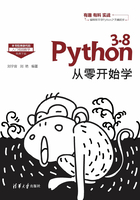
上QQ阅读APP看书,第一时间看更新
4.3.3 join()方法
join()方法用于将序列中的元素以指定字符串连接成一个新字符串。join()方法的语法格式如下:
str.join(sequence)
此语法中,str代表指定的字符串,sequence代表要连接的元素序列。返回结果为指定字符串连接序列中元素后生成的新字符串。
该方法的使用示例如下:
>>> say=('stay hungry','stay foolish')
>>> new_say=','.join(say)
>>> print(f'连接后的字符串列表:{new_say}')
连接后的字符串列表:stay hungry,stay foolish
>>> path_str='d:','python','study'
>>> path='/'.join(path_str)
>>> print(f'python file path:{path}')
python file path:d:/python/study
>>> num=['1','2','3','4','a','b']
>>> plus_num='+'.join(num)
>>> plus_num
'1+2+3+4+a+b'
>>> num=[1,2,3,4]
>>> mark='+'
>>> mark.join(num)
Traceback (most recent call last):
File "<pyshell#39>", line 1, in <module>
mark.join(num)
TypeError: sequence item 0: expected str instance, int found
>>> num.join(mark)
Traceback (most recent call last):
File "<pyshell#40>", line 1, in <module>
num.join(mark)
AttributeError: 'list' object has no attribute 'join'
由输出结果可以看到,join()方法只能对字符串元素进行连接,用join()方法进行操作时,调用和被调用的对象必须都是字符串,任意一方不是字符串,最终操作结果都会报错。
在实际项目应用中,join()方法应用得也比较多,特别是在做字符串的连接时,使用join()方法的效率比较高,占用的内存空间也小。在路径拼接时,使用join()是个不错的选择。